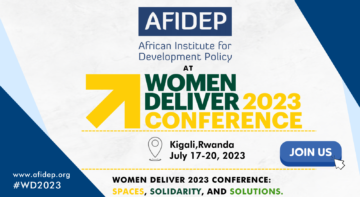Blogs

Kenya’s rapid population growth is well acknowledged as a threat to development efforts. This is the reason why government efforts through the National Council for Population and Development (NCPD) have, over the years, focused on increasing use of contraception among married women and men to reduce chances of having more children than couples are able to care for.
The recently released 2014 Kenya Demographic and Health Survey (DHS) revealed that use of contraception increased from 39 percent in 2008 to 53 percent in 2014. This is a huge leap and it exceeds the target set by the Population Policy for National Development (2012) of 52 per cent for modern contraceptive use by 2015.
This has created a lot of optimism and hope that the country can actually achieve the 2030 target of 70 percent modern contraceptive use among married women. And indeed, it is for this reason that Kenya was feted with the Excellence in Leadership for Family Planning (EXCELL) Award in recognition of the excellent achievement in contraceptive use during the International Conference on Family Planning (ICFP) held in Nusa Dua, Indonesia in January 2016.
This good performance for Kenya has been credited to improved commodity security and good management and coordination of partners, increased equity in use of contraceptives. Commodity security means that high quality and adequate contraceptives are available at health facilities and accessible to all those who require them.
But there are two reality checks for Kenya. Firstly, there are huge geographical and socio-demographic disparities in contraceptive use. Less than 10 percent of women use modern contraceptives in North Eastern counties, including Mandera (1.9 percent), Wajir (2.3 percent) and Garissa (5.5 percent). Whereas, in counties in the Central region, more than two out of every three women use modern contraceptives, including in Kirinyaga (76 percent), Meru (73 percent) and Kiambu (68 percent).
In addition, contraceptive use among married young women (15-19 years) is low, at 37 percent, yet these are the women at risk of having unintended pregnancies because of their young age, which further puts their lives at risk. Furthermore, 18 percent of married women; that is about one in every five married women, who would like to delay pregnancy or stop child bearing all together, were not using contraceptives because of various reasons. Again, these are women with huge chances of getting unintended pregnancies.
Secondly, Kenya needs to realise that it will be increasingly more difficult to increase contraceptive use from 53 per cent to 70 percent by 2030. Evidence shows that once a country reaches higher levels of contraceptive use, further increase in contraceptive use slows down. This is because non-users of family planning are mostly those not predisposed to use contraception due to self-assessment of inability to get pregnant, concern about side effects, and religious or cultural beliefs. Kenya therefore has to think differently and more critically about what strategies to implement to reach the unreached women and men with family planning services.
The Ministry of Health (MoH) recently convened a post-conference meeting for partners to share lessons learned from the ICFP, and to forge a joint strategy for the family planning programme in the country. Participants noted that most of the strategies for improving contraceptive use that were presented by other countries during the conference were already happening in Kenya, albeit at a small scale. To illustrate, the community-based family planning services that is credited for increased contraceptive use in Ethiopia, use of voucher system to facilitate access to contraceptive services for the under-privileged, and involvement of the private sector in service delivery that worked very well in other countries, have been in implementation in Kenya for several years. The questions then is, why aren’t these strategies bearing significant results in Kenya? Or is it a case of poor knowledge sharing on what is being done by each partner and sharing of lessons on the results realised?
What does Kenya need to do to overcome these challenges?
To surmount these challenges, Kenya may need to stop the “business as usual’ model and rethink the current approach. First, we need to rethink the measurement of contraceptive use, whether to highlight the additional users reached, or the proportion of women currently using contraceptives. Both indicators are available in the demographic and health surveys done every five years. By highlighting the additional users, those who discontinued contraceptive use will also be highlighted, and the reasons for discontinuation will be given attention to. This will help us define what growth is realistic, identify the strategies to achieve that growth, and what tools to use to realise that growth.
Kenya is among the countries that made commitments at the 2012 London Summit on Family Planning towards the ambitious FP2020 goal of enabling an additional 120 million women and girls in the world’s 69 poorest countries to access modern contraceptive methods. How do we measure our contribution towards this goal?
It is clear that good leadership from the national to the community level will be key in increasing contraceptive use. Focused advocacy with clear messaging to all leaders whether political or religious should be a priority. Currently, county governments are not allocating funds for procurement of contraceptives. Given that this is a devolved function, the central government cannot continue procuring commodities, and a more sustainable strategy will need to be developed.
One group of leaders we can leverage on is the county first ladies who have a huge influence on the governors. For example, the Kitui County First Lady, Edith Malombe, has been very instrumental in advocating for creation of a budget line for family planning services, and about Kshs. 16 million was allocated for family panning services in the 2015-2016 budget presented to the County Assembly.
Importantly, knowledge management and sharing of best practices is key going forward, as this will provide information on what works and what is scalable. There are many strategies on contraceptive uptake that have been implemented in different parts of the country, some very successful, but are barely known by others implementing on the family planning arena. The first step is documentation of all projects despite the scale. As the mantra goes, if it is not documented, it never happened. The next step is sharing what has been documented and the lessons learned.
Knowledge management informs quality of services, which is key in improving uptake of family planning services. As suggested during the post-conference meeting, knowledge sharing can be facilitated by a country family planning conference, as has been done in Uganda and Malawi. This will bring in various implementers to share and learn from each other.
Kenya should take advantage of the increased resources and heightened interest in increasing uptake of contraceptives. The country should also align with the global institutions that are ready to fund family planning programmes like the Bill and Melinda Gates Foundation, and coordinate all local and international partner efforts towards addressing inequality in access to family planning services, through reaching population groups and geographical areas that lag behind in contraceptive use.
Eunice Mueni is a Knowledge Translation Officer. eunice.mueni@afidep.org
Related Posts





